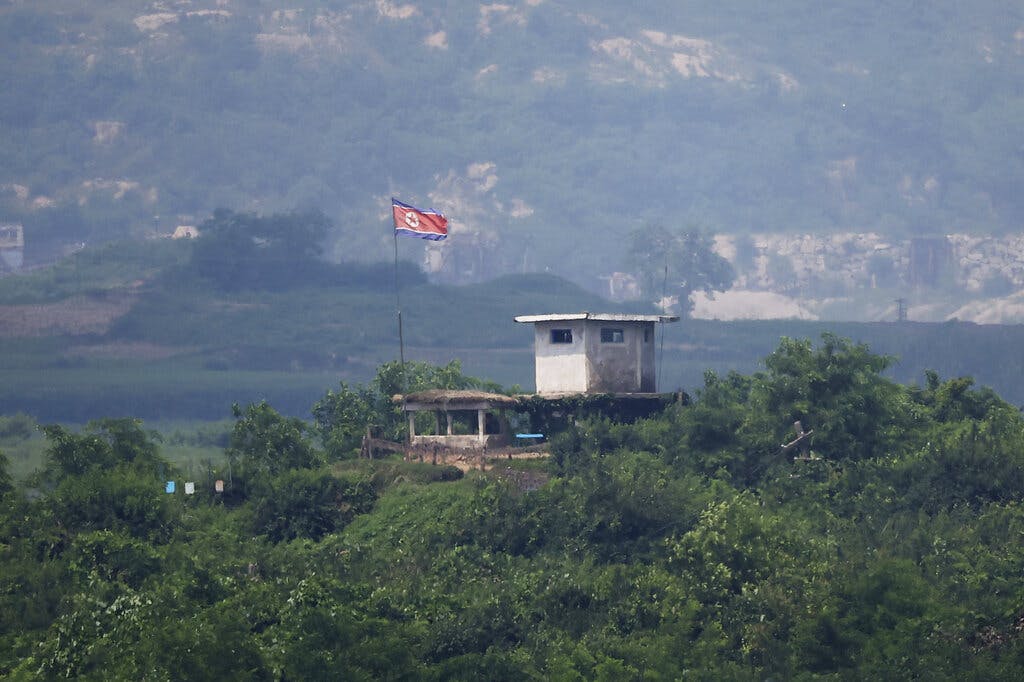Seoul Eyes Hiking Trails for Tourists in the Demilitarized Zone Dividing Korea, Even as Peace Prospects Look Dimmer Than Ever
The prospect of tourism south of the line where thousands of soldiers were killed between 1950 and 1953 seems like a relief from decades of tension, recriminations and occasional rifle shots.

From the observation tower in the northeastern corner of South Korea you can see the distant crags of Mount Kumgang inside North Korea. Down steep steps from the tower, a rocky trail leads to the 2.5-mile-wide demilitarized zone that’s divided the two Koreas since the Korean War ended in an armed truce 70 years ago.
A yellow-painted board crosses the trail marking the southern side of the DMZ. A barbed-wire shields the path from the beach. A railroad track, never used since it was completed 16 years ago, winds from South to North — mute testimony to the frustrations of ever coming to terms between the two Koreas. Beyond the DMZ, a North Korean watch tower is visible on a far slope.
Soon, say officials accompanying us, they hope to open a dozen trails along the southern side of the DMZ to tourism. Small deer and wild pigs range free within the DMZ, uninhibited by encroaching development, even as North and South Korean soldiers eye one another from either side of the zone.
Despite this tranquil scene, the prospect of peace between the two Koreas appears at its lowest point in years. Back at Seoul, the chairman of a Korean government-financed think tank named the Sejong Institute, Lee Yong-jeon, acknowledged it was “ impossible to achieve real denuclearization” in talks with the North Koreans. They “will not agree to full-scale disarmament.”
The North’s leader, Kim Jong-un, isn’t responding to requests for talks, but Mr. Lee believes they would be useless even if negotiators again faced each other — something that hasn’t happened since President Trump met Mr. Kim for an impromptu meeting at the truce village of Panmunjom, 40 miles north of Seoul, in June 2019.
If there’s one thing that’s obvious, said Mr. Lee, it’s that three previous decades of sporadic talks in different venues, with different casts of negotiators, “have failed to deter North Korea’s ambition.” Even if talks resumed, he said, “progress in denuclearization” just won’t work.
True, the North hasn’t conducted another nuclear test since its sixth test in September 2017, but Mr. Lee thinks that’s due to “delays in development of tactical nuclear weapons,” not to any desire to ease tensions. He estimates that North Korea, producing nuclear warheads at a rate of five a year, as of 2020 had “around 100 warheads.”
In Pyongyang, a long-time commentator, Tong Thae-gwan, writing in the Workers’ Party newspaper, Rodong Sinmun, supported that analysis. The North’s “nuclear force has sharply increased and firmly reached the world’s strongest level,” he wrote, presumably at the behest of Mr. Kim.
It’s difficult to worry about a North Korean attack, whether by artillery always trained on South Korea’s capital, Seoul, and biggest port, Incheon. The prospect of regular tourism south of the line where thousands of Americans and South Koreans, also soldiers from 16 other UN members, were killed between 1950 and 1953 seems like a relief from decades of tension, recriminations and occasional rifle shots.
But appearances can be deceiving. The former director of the Los Alamos National Laboratory Siegfried Hecker, believes America missed a final opportunity for reaching a deal with North Korea when President Trump walked out of his second summit with Kim Jong Un in Hanoi in February 2019. They were supposed to be reaching a deal, but instead Mr. Kim went home “angry and frustrated.”
“I believe we had an opportunity, and we missed it,” said Mr. Hecker, talking at Ewha University. “Now we have to see what we can do to get it back.” Since then, he said, North Korea “has made a fundamental strategic change” — aligning with Russia and China while forgetting about seeking normalization with America.
Mr. Hecker warns that “all South Korea” and “most of Japan” is within reach of North Korean nuclear weapons, and “they can put them” into long-range missiles capable of reaching North America.
He’s not impressed by the outward signs of peace like the opening up of hiking trails along the DMZ.“For the life of me, I don’t see why we’re not more concerned,” he said.
After a week-long “DMZ Freedom and Peace Grand March” along the South Korean side of the DMZ, Kang Min-joo could only think “how precious and grateful I am for the freedom and peace I have.”

